 The Mju film compact range has been a great success for Olympus, with people being drawn to the ultra compact and stylish bodies. Now the range is being expanded into the digital realm and we’re looking at one of the first such models, the Mju 300 digital. There’s also the Mju 400 digital, which has a main difference of an extra megapixel. There’s more to these cameras than being the first in the Digital Mju range, as the feature list below shows.
The Mju film compact range has been a great success for Olympus, with people being drawn to the ultra compact and stylish bodies. Now the range is being expanded into the digital realm and we’re looking at one of the first such models, the Mju 300 digital. There’s also the Mju 400 digital, which has a main difference of an extra megapixel. There’s more to these cameras than being the first in the Digital Mju range, as the feature list below shows.
Olympus Mju 300 Digital Features
- 3.2 megapixels
- 3x optical zoom f3.1-f5.2 (35-105mm in 35mm format)
- 5 scene programs
- Movie recording
- Weatherproof metal body
- xD picture card slot
- +/- 2EV in 1/3 EV steps
- ISO 80-320 (Automatic)
- 4 White balance presets
- USB, Video-out and power-in connections
- Remote controller supplied
Handling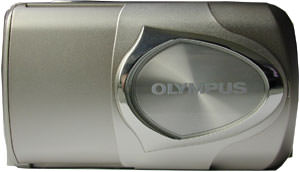 The first important feature to note with the new digital Mju, is the weatherproof metal body. Whilst we weren’t able to verify this weather proofing (Olympus wouldn’t be happy if we drowned their new camera!), the seals surrounding the various covers and buttons of the camera look able to do their job. The manual has a guide to the weatherproofing feature, clearly stating that you shouldn’t “wash the camera with water”, “drop the camera into water” or “take pictures underwater”. The weatherproofing is really more of a safety blanket than an invitation to go taking pictures in the next monsoon.
The first important feature to note with the new digital Mju, is the weatherproof metal body. Whilst we weren’t able to verify this weather proofing (Olympus wouldn’t be happy if we drowned their new camera!), the seals surrounding the various covers and buttons of the camera look able to do their job. The manual has a guide to the weatherproofing feature, clearly stating that you shouldn’t “wash the camera with water”, “drop the camera into water” or “take pictures underwater”. The weatherproofing is really more of a safety blanket than an invitation to go taking pictures in the next monsoon.
This camera certainly has a high “wow-factor”, and when we picked it out of its box we were immediately impressed by the solid, cold metallic feel of the body. It’s still a light camera though, in fact it’s one of those cameras you could forget about if it was in a jacket pocket.
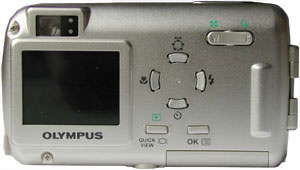 The overall finish of the Mju is also to a very good standard, everything appears well built and the front cover slides open and shut with a decidedly high quality feel. With some metallic finishes, it’s easy for the camera to get covered in fingerprints and smudges and have the stylish effect ruined. The Mju Digital body isn’t affected like this however, as the body material looks able to resist most common marks.
The overall finish of the Mju is also to a very good standard, everything appears well built and the front cover slides open and shut with a decidedly high quality feel. With some metallic finishes, it’s easy for the camera to get covered in fingerprints and smudges and have the stylish effect ruined. The Mju Digital body isn’t affected like this however, as the body material looks able to resist most common marks.
The control layout is about as simple as it could be and the uncluttered look helps the stylish appearance. A minor niggle is that when using the 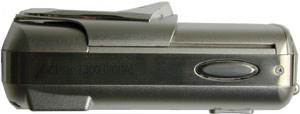 camera menus, it was too easy to accidentally push the lens cover. When pushed the camera thinks it needs to change from record mode to playback mode so you get cut off from the menu you were trying to access.
camera menus, it was too easy to accidentally push the lens cover. When pushed the camera thinks it needs to change from record mode to playback mode so you get cut off from the menu you were trying to access.
The top of the camera is empty apart from the solitary shutter release button. This really is a very simple to operate camera and should be easy to learn to use for most people. After pulling back the lens cover, the lens comes out quite quickly and the camera is ready to use in about two seconds.
Menu system
In keeping with the simple exterior, the Mju menu system is also simple and easy to use. Like the majority of modern digital cameras, the menus react almost instantly to key presses making it quick to change the desired settings. There’s the all important quick preview function, which is activated by double pressing the playback button. The alternative is to switch to playback mode, by sliding the front cover to the left a notch.
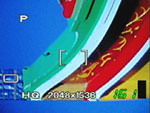 |
The display when in picture-taking mode has very little information on it. Those people accustomed to the more feature-rich of digital cameras may expect to see information about shutter and aperture settings. There is useful information on the quality mode you are in and the number of shots remaining, plus a clear indicator to whether or not a good focus lock has been achieved. |
| Live record view | |
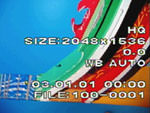 |
Whether as a cost cutting measure, or simply to keep the camera as easy to use as possible, there is no histogram facility in playback mode. Whilst a histogram isn’t a vital feature and many people wouldn’t notice its absence, the fact is many other ultra-compact digital cameras include them. |
| Playback mode | |
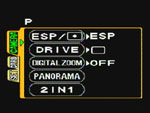 |
With the first press of the menu button, you are given options to change the image quality setting, exposure compensation and white balance, or go into the mode menu. The mode menu lets you change the following camera features: Metering mode (ESP or spot), Drive mode (Single-frame or sequential), Digital Zoom (on/off), Panorama mode (on/off), 2in1 (Combines two pictures as one). |
| Setup mode |
Camera modes and operation
Besides the Program Auto mode, which is the default mode of the camera, there are six other modes. These are Portrait, Landscape and Portrait, Landscape, Night Scene, Self Portrait and Movie. The movies are only up to 16 seconds long in HQ mode and up to 70 seconds in SQ mode and don’t include sound.
What’s probably more important to most photographers than these scene modes, is the speed of camera operation in normal shooting mode. The focusing speed is much on par with other digital compacts, with a few seconds required to lock in most cases. Shot to shot times are good, with only a second between shots as the camera prepares to write the last shot to card, though with it being an autofocus only camera you need to wait for the focus lock again. Switching to sequential mode gets around having to wait to for the focus each time. In HQ mode, sequential mode allowed us to take 27 photos, at approximately 1 frame per second. In SHQ mode, this number was cut down to 7 photos, still at 1 frame per second.
The Mju is provided with a rechargeable lithium-ion battery pack with its own charger. Even leaving the LCD on for most of the time, we got a lot of use from the Mju and its battery performance is at least at the same level as many rival digital compacts.
Viewfinder and LCD screen
The viewfinder on the Mju is a very simple one, requiring a fair amount of squinting to look through. There’s no diopter adjustment and most users will probably rely on the LCD screen which will give a better view of what your image will actually look like.
The LCD is only a millimeter or so below the metal surrounding it and it has what appears to be a fairly scratch resistant plastic surface. When used on fast moving subjects, the LCD like so many others struggles to keep up, resulting in a mild ghosting effect. If used on stationary or slow moving objects, the display is clear, colourful and bright.
Image quality
Stylish ultra-compact digital cameras aren’t generally regarded as capable of providing the best image quality. Olympus have had a lot of experience in this area though and we were hoping that the Mju 300 wouldn’t be a case of style over substance. The options available in the camera menus for settings affecting image quality are quite limited, so you’re going to be reliant on the default settings being good enough to start with.
The resolution of the CCD is more than good enough for the snapshots this camera is perhaps intended for. The more critical of photographers may be very slightly disappointed by a small degree of softness to the images, but it isn’t something most people will notice. Colours appear accurate and most photos taken with the Mju were pleasing to the eye. The metering system works well and the choice of metering modes and exposure compensation is good to have.
Problems we had included some chromatic aberrations as shown in one of our sample images below, but this only affects a small number of photos taken. It’s also a pity that a custom white balance option wasn’t provided, which could make the difference between a usable and unusable shot in some conditions. The macro mode capability of the Mju is only OK, but focussing speeds in general are above average.
Sample images

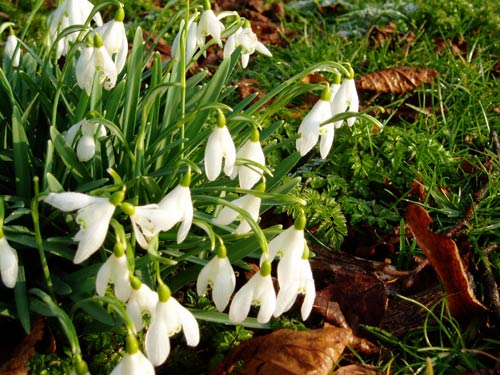
This is about as close as the macro mode on the Mju would let us get.
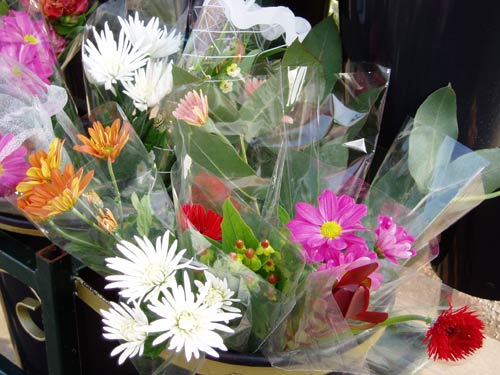
Although colourful, the shot above is slightly spoilt by the chromatic aberration shown in the 1:1 crop below.
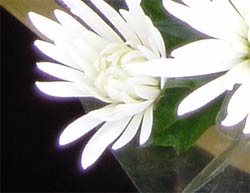

The shot 1:1 crop below of the image above shows the Mju is capable of capturing a good amount of detail.
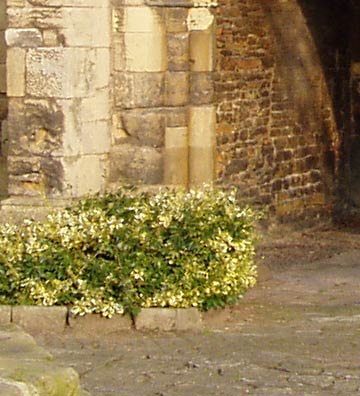

Verdict
The Mju 300 is an impressive camera held in the hand and its smoothly styled body is nice to use. The available camera options are going to satisfy the majority of casual happy snappers and some enthusiasts. Images produced were generally very pleasing and for a digital compact with the uniqueness of an all-weather and stylish body, Olympus have done well. This is certainly a digital compact we’d recommend you consider.
In summary the main positive points of the Olympus Mju Digital 300 are:
![]() Stylish all-weather body
Stylish all-weather body![]() Reasonable price of around 350
Reasonable price of around 350![]() Simple to use for beginners
Simple to use for beginners![]() Good resolution
Good resolution![]() Reliable metering system
Reliable metering system![]() Accurate and pleasing colourful images
Accurate and pleasing colourful images![]() Decent battery-life
Decent battery-life
Negative points are:
![]() Minor softness to some images
Minor softness to some images![]() Lack of custom white balance setting
Lack of custom white balance setting![]() Occasional chromatic aberrations
Occasional chromatic aberrations![]() Lack of manual modes will deter some enthusiasts
Lack of manual modes will deter some enthusiasts
Discuss this review and other digital cameras here.